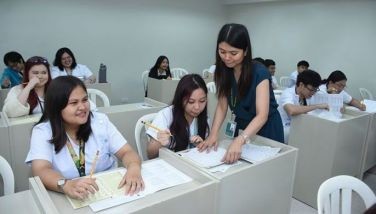Medicine and education
The Health Panel of the Congressional Commission on Science, Technology, and Engineering (COMSTE) has come up with recommendations to improve the country’s competitiveness in the health sciences. One recommendation affects education: “All universities [should] set their priority R&D agenda for the top ten killer diseases in the country.”
What are the top ten killer diseases in the country? According to the Department of Health (doh.gov.ph), these are, in order: “(1) heart diseases; (2) vascular systems diseases; (3) malignant neoplasm; (4) accidents; (5) pneumonia; (6) tuberculosis; (7) signs, symptoms, abnormal clinical laboratory findings, NEC; (8) chronic lower respiratory diseases; (9) Diabetes Mellitus; and (10) certain conditions originating in the perinatal period.”
Not being a medical doctor, I cannot talk scientifically about these top diseases. I can, however, talk about them as an educator.
It is clear that one of the major reasons people get sick in our country is scientific illiteracy, or plainly and simply, ignorance. Ignorance takes many forms, from the superstition of unlettered folk to the pseudo-science of TV-advertised tea bags. For example, most Filipinos still believe that, if the top of your head gets wet from rain, you will get pneumonia. Even some otherwise sophisticated golfers think that playing golf grants immunity from heart attacks. Millions of pesos have been spent by television viewers believing in advertisements about herbs that can cure every disease from colds to diabetes.
How can we combat scientific illiteracy? By making all our students scientifically literate.
That is actually not very hard to do. Suppose every elementary school student were introduced to the old DOH mascot Yosi Kadiri. That will surely make cigarette smoking less attractive when they reach the age of experimentation with tobacco.
Suppose every high school student were taught anatomy in a way that they can understand (and not simply memorize as they are doing today) the nature and function of each major part of the body. That will surely make them aware of why eating fatty and salty food will shorten their lives.
Suppose every female college student were forced to have breast cancer tests every year they are in school. That will surely get them into the habit of making sure they catch breast cancer early enough to cure it.
Suppose every male college student (and even female, in these days of feminism) were taught to be accident-conscious, then we would not have what a doctor-blogger criticizes about us: “I have not seen a worker operating a jack hammer wearing any ear protection – only in the Philippines!” (emeritus.blogspot.com)
That doctor-blogger writes, by the way, “The joke is that you are not a Filipino if you do not have TB.” Unfortunately, as the blogger notes, tuberculosis is not a joke. Education can easily correct the main cause of the spread of tuberculosis in our country, which the blogger says is this: “The problem is that most Filipinos ignore their symptoms, continue to roam around and spread the infection, and consult only when there is blood coming out when they cough.” We could train all Grade One pupils to use handkerchiefs, tissues, or even just their cupped hands whenever they cough, whether the cough is caused by the common cold or actual tuberculosis.
Scientific literacy, like cultural literacy, does not come naturally to human beings. It has to be taught systematically, with each grade level being expected to have two or three minimum learning competencies. Just like cultural literacy, scientific literacy does not consist only of knowledge, but also of attitudes and habits. (Of course, since you cannot give what you do not have, scientifically and culturally illiterate teachers are a problem, but that’s another story.)
Literacy of all kinds cannot be legislated. COMSTE can only do so much. What DepEd should do is to revisit its 20th century list of minimum learning competencies and ensure that these inculcate scientific literacy, cultural literacy, and all the other literacies necessary for survival in the 21st century.
“WORDS OF THE DAY” (English/Filipino) for next week’s elementary school classes: Oct. 13 Monday: 1. bite/queer, 2. cod/quiz, 3. catfish/quintet, 4. camachile/quality, 5. firefish/reseta, 6. sandperch/retaso; Oct. 14 Tuesday: 1. seat/ranggo, 2. scat/raya, 3. milkfish/ratiles, 4. willow/qualified, 5. bigeye/raket, 6. longfin/radikal; Oct. 15 Wednesday: 1. bath/radyo, 2. shark/rali, 3. tilefish/repolyo, 4. zinnia/resibo, 5. salmon/relasyon, 6. silverside/rekwerdo; Oct. 16 Thursday: 1. dust/sabaw, 2. trout/sala (fault), 3. bream/sabit, 4. molave/sabik, 5. mullet/sabog, 6. organization/sabsab; Oct. 17 Friday: 1. blue/sadya, 2. tuna/salop, 3. sprat/salin (translation), 4. poinsettia/saklolo, 5. grunter/sampal, 6. ponyfish/sagwan. The numbers after the dates indicate grade level. The dates refer to the official calendar for public elementary schools. For definitions of the words in Filipino, consult UP Diksiyonaryong Filipino.
- Latest
- Trending

























